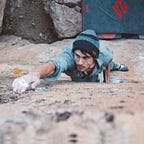Sprinter: Part I
Half a year ago I moved into a used ’06 Dodge Sprinter. My plan was to be
“suffering-oriented” — to avoid adding any unnecessary luxury before it was needed.
A few months later it’s winter; a storm hits, dumping rain for days, and my unventilated metal cave becomes a terrarium: water drips from the ceiling, there’s a pervasive chill, it is somehow both cold and uncomfortably hot, strange things begin to grow in the corners…
My predominant emotion was rage. It was pure and simple and directed entirely at my living quarters; I hated the vehicle and my situation. But I eventually found that I could channel that negative energy into improving things, and I started making real changes — I added insulation, a ceiling vent, solar power, a hardwood floor, and began envisioning schematics for a modular space built on a cargo-hauling system called “e-trak”.
The vehicle became a chaotic tapestry. It ceased to be useful, particularly when I hauled the bed out, and began to look like a space ship.
I pored over inscrutable diagrams, like this one:
Along the way, I upgraded my tools and techniques, and I discovered a few lessons about what mindset was required to have success in a project such as this. I had no idea beforehand how much work it would be, and I had to gradually dampen my expectations and force myself to be more realistic. I (re-)learned the value of focusing on one thing at once, I became better at estimating, and I started ignoring any voices in my head that said “you don’t know what you’re doing!”. Those voices were right, but they weren’t productive!
I purchased a workbench, circular saw, jigsaw, router — and Youtube became my mentor.
—
I met Angeli midwinter, and she’s awesome :) She’s helped me a lot with the Sprinter — here she is doing some work on the underlayment for my hardwood floors:
The floor was grueling and filled with uncertainty. We had to discard the conventional wisdom on how to lay hardwood, because I had tight vertical constraints — you see, I wanted to still be able to stand straight in my vehicle, and I’m 6'1"…
I eventually settled on a multi-layer approach which included two foil-faced insulation layers, two sure-ply layers, and a layer of sound-deadening mass-loaded vinyl (see above picture) to both even out the corrugated metal surface, and provide good acoustical properties.
The floor was a monumental undertaking, but when the final layer began to take shape, and we saw the final result… there was such a feeling of joy and accomplishment!
—
Winter began to fade, and spring arrived. The days got longer, and I began adventuring again. Here are some shots from in and around Bishop, CA:
The coast of California:
I went wandering around the Sibley Volcanic Preserve one day, and found some cows:
I ended up in Utah with my friend Adam — we travelled to Zion and hiked, and I did my first mountain biking.
—
Lately, my favorite haunt has been Yosemite National Park. It’s famous for climbers, because much of the evolution of rock climbing as a sport has come from there…
Here’s Angeli climbing an “off-width” crack near the generator station on the river (speaking of suffering-oriented ;)
Here’s the “Midnight Lightning” boulder (look for the little people for perspective):
—
One day I decided to make Angeli a climbing brush; her birthday was around the corner and she had lost hers, so I found a nice piece of mahogany with a cool grain and started carving.
The piece is tapered so you can easily place it in a toolbelt (and it will catch at a certain width), it’s long so that you get more leverage, and it is curved so that you can dig it into hard to reach “crimps” and other places with greater ease. It’s mahogany, and the grain runs lengthwise so it’s strong.
I treated it with tung oil, which polymerizes with the wood to form an exterior layer of durable weather proofing — and which has the added bonus of making the grain “pop”, to make it come to life and really have a kind of glow. It’s also really easy to maintain and completely non-toxic.
I then drilled holes in the brush and threaded it with tampico bristles, which come from a tree that grows in northern Mexico, and which are particularly hard and durable — perfect for scraping against rock. She really liked it!
—
Lets see, here’s a photo of me doing something stupid:
And here’s a photo I took while doing something… ahem, adventurous:
And here’s a photo of the beginnings of the modular system I was referring to earlier, which has evolved since then:
As you can see, it can easily support a bed and other structures that you can sort of invent on-the-fly using basic materials.
That’s it for now. Stay tuned for Part II!
